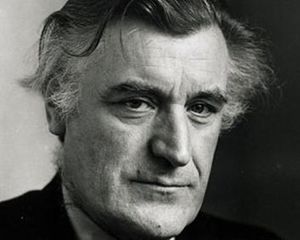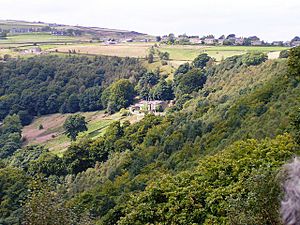Ted Hughes facts for kids
Quick facts for kids
Ted Hughes
|
|
|---|---|

Hughes in later life
|
|
| Poet Laureate of the United Kingdom | |
| In office 28 December 1984 – 28 October 1998 |
|
| Monarch | Elizabeth II |
| Preceded by | John Betjeman |
| Succeeded by | Andrew Motion |
| Personal details | |
| Born |
Edward James Hughes
17 August 1930 Mytholmroyd, Yorkshire, England |
| Died | 28 October 1998 (aged 68) London, England |
| Cause of death | Myocardial infarction (heart attack) |
| Spouses |
|
| Domestic partner | Assia Wevill (1962–1969) |
| Children |
|
| Alma mater | Pembroke College, Cambridge |
| Occupation | Poet, playwright, writer |
Edward James Hughes OM OBE FRSL (17 August 1930 – 28 October 1998) was an English poet, translator, and children's writer. Critics frequently rank him as one of the twentieth century's greatest writers. He was appointed Poet Laureate in 1984 and held the office until his death. In 2008 The Times ranked Hughes fourth on its list of "The 50 greatest British writers since 1945".
Early life
Hughes was born at 1 Aspinall Street, in Mytholmroyd in the West Riding of Yorkshire, to William Henry (1894–1981) and Edith (née Farrar) Hughes (1898–1969), and raised among the local farms of the Calder Valley and on the Pennine moorland.
Hughes's father, William, a joiner, was of Irish descent and had enlisted with the Lancashire Fusiliers in the First World War and fought at Ypres.
Hughes loved hunting and fishing, swimming, and picnicking with his family. He attended the Burnley Road School until he was seven before his family moved to Mexborough, then attending Schofield Street junior school. His parents ran a newsagent's and tobacconist's shop. In Poetry in Making he recalled that he was fascinated by animals, collecting, and drawing toy lead creatures. He acted as retriever when his elder brother gamekeeper shot magpies, owls, rats and curlews, growing up surrounded by the harsh realities of working farms in the valleys and on the moors. During his time in Mexborough, he explored Manor Farm at Old Denaby, which he said he would come to know "better than any place on earth". His earliest poem "The Thought Fox", and earliest story "The Rain Horse" were recollections of the area. A close friend at the time, John Wholly, took Hughes to the Crookhill estate above Conisbrough where the boys spent great swathes of time. Hughes became close to the family and learnt a lot about wildlife from Wholly's father, a gamekeeper. He came to view fishing as an almost religious experience.
Hughes attended Mexborough Grammar School, where a succession of teachers encouraged him to write, and develop his interest in poetry. Teachers Miss McLeod and Pauline Mayne introduced him to the poets Gerard Manley Hopkins and T.S. Eliot. Hughes was mentored by his sister Olwyn, who was well versed in poetry, and another teacher, John Fisher. Poet Harold Massingham also attended this school and was also mentored by Fisher. In 1946, one of Hughes's early poems, "Wild West", and a short story were published in the grammar school magazine The Don and Dearne, followed by further poems in 1948. By 16, he had no other thought than being a poet.
During the same year, Hughes won an open exhibition in English at Pembroke College, Cambridge, but chose to do his national service first. His two years of national service (1949–51) passed comparatively easily. Hughes was stationed as a ground wireless mechanic in the RAF on an isolated three-man station in east Yorkshire, a time during which he had nothing to do but "read and reread Shakespeare and watch the grass grow". He learnt many of the plays by heart and memorised great quantities of W. B. Yeats's poetry.
Career
In 1951 Hughes initially studied English at Pembroke College under M. J. C. Hodgart, an authority on balladic forms. Hughes felt encouraged and supported by Hodgart's supervision, but attended few lectures and wrote no more poetry at this time. He did not excel as a scholar, receiving only a third-class grade in Part I of the Anthropology and Archaeology Tripos in 1954. His first published poetry appeared in Chequer.
After university, living in London and Cambridge, Hughes went on to have many varied jobs including working as a rose gardener, a nightwatchman and a reader for the British film company J. Arthur Rank. He worked at London Zoo as a washer-upper, a post that offered plentiful opportunities to observe animals at close quarters.
Hughes was married to American poet Sylvia Plath from 1956 until her death in 1963. Following Plath's death, Hughes wrote two poems "The Howling of Wolves" and "Song of a Rat" and then did not write poetry again for three years. He broadcast extensively, wrote critical essays and became involved in running Poetry International with Patrick Garland and Charles Osborne in the hopes of connecting English poetry with the rest of the world. In 1966, he wrote poems to accompany Leonard Baskin's illustrations of crows, which became the epic narrative The Life and Songs of the Crow, one of the works for which Hughes is best known.
Hughes was appointed Poet Laureate in December 1984, following Sir John Betjeman. A collection of animal poems for children had been published by Faber earlier that year, What is the Truth?, illustrated by R. J. Lloyd. For that work he won the annual Guardian Children's Fiction Prize, a once-in-a-lifetime book award. Hughes wrote many works for children and collaborated closely with Peter Brook and the National Theatre Company. He dedicated himself to the Arvon Foundation which promotes writing education and runs residential writing courses at Hughes's home at Lumb Bank, West Yorkshire. In 1993, he made a rare television appearance for Channel 4, which included him reading passages from his 1968 novel The Iron Man. He also featured in the 1994 documentary Seven Crows A Secret.
In early 1994, Hughes became increasingly alarmed by the decline of fish in rivers local to his Devonshire home. This concern inspired him to become one of the original trustees of the Westcountry Rivers Trust, a charity set up to restore rivers through catchment-scale management and a close relationship with local landowners and riparian owners.
Hughes was appointed a member of the Order of Merit by Queen Elizabeth II just before he died. He continued to live at the house in Devon, until suffering a fatal heart attack on 28 October 1998 while undergoing hospital treatment for colon cancer in Southwark, London. His funeral was held on 3 November 1998, at North Tawton church, and he was cremated in Exeter.
Commemoration and legacy
A memorial walk was inaugurated in 2005, leading from the Devon village of Belstone to Hughes's memorial stone above the River Taw, on Dartmoor, and in 2006 a Ted Hughes poetry trail was built at Stover Country Park, also in Devon.
On 28 April 2011, a memorial plaque for Hughes was unveiled at North Tawton by his widow Carol Hughes. At Lumb Bridge near Pecket Well, Calderdale is a plaque, installed by The Elmet Trust, commemorating Hughes's poem "Six Young Men", which was inspired by an old photograph of six young men taken at that spot. The photograph, taken just before the First World War, was of six young men who were all soon to lose their lives in the war. A Ted Hughes Festival is held each year in Mytholmroyd, led by the Elmet Trust, an educational body founded to support the work and legacy of Hughes.
In 2010, it was announced that Hughes would be commemorated with a memorial in Poets' Corner in Westminster Abbey. On 6 December 2011, a slab of Kirkstone green slate was ceremonially placed at the foot of the memorial commemorating T. S. Eliot. Poet Seamus Heaney and actress Juliet Stevenson gave readings at the ceremony, which was also attended by Hughes's widow Carol and daughter Frieda, and by the poets Simon Armitage, Blake Morrison, Andrew Motion and Michael Morpurgo. Motion paid tribute to Hughes as "one of the two great poets of the last half of the last century" (the other being Philip Larkin). Hughes's memorial stone bears lines from "That Morning", a poem recollecting the epiphany of a huge shoal of salmon flashing by as he and his son Nicholas waded a stream in Alaska: "So we found the end of our journey / So we stood alive in the river of light / Among the creatures of light, creatures of light."
In October 2015, the BBC Two major documentary Ted Hughes: Stronger Than Death examined Hughes's life and work. The programme included contributions from poets Simon Armitage and Ruth Fainlight, broadcaster Melvyn Bragg, biographers Elaine Feinstein and Jonathan Bate, activist Robin Morgan, critic Al Alvarez, publicist Jill Barber, friend Ehor Boyanowsky, patron Elizabeth Sigmund, friend Daniel Huws, Hughes's US editor Frances McCullough, and younger cousin Vicky Watling. His daughter Frieda spoke for the first time about her father and mother.
Archive
Hughes archival material is held by institutions such as Emory University and Exeter University. In 2008, the British Library acquired a large collection comprising over 220 files containing manuscripts, letters, journals, personal diaries, and correspondence. The library archive is accessible through the British Library website.
There is also a Collection Guide available grouping together all of the Hughes material at the British Library with links to material held by other institutions. Inspired by Hughes's Crow the German painter Johannes Heisig created a large painting series in black and white which was presented to the public for the first time on the occasion of Berlin Museum Long Night in August 2011 at the SEZ Berlin.
Images for kids
-
Homage to Ted Hughes by Reginald Gray (2004), Bankfield Museum, Halifax.
See also
 In Spanish: Ted Hughes para niños
In Spanish: Ted Hughes para niños





